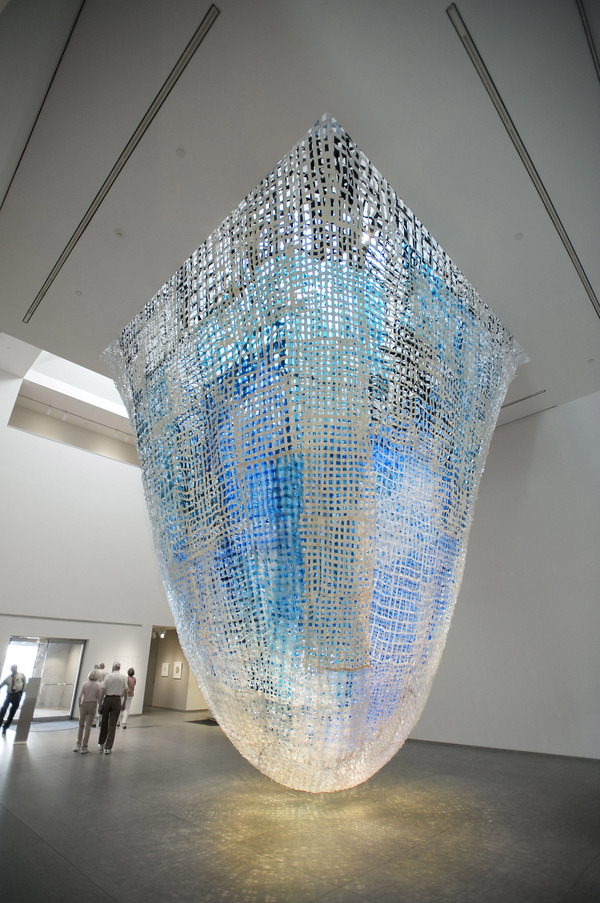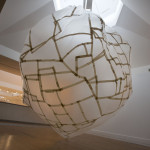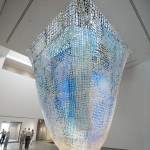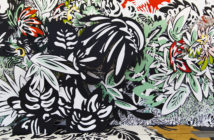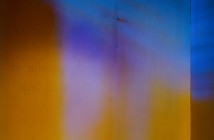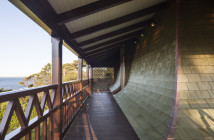“I want to say one word to you. Just one word…Plastics.” Yes, the quote is from the film The Graduate. I love that quote, and never pass up a chance to use it. And it’s the perfect introduction for Anna Hepler’s plastastic exhibition titled, Makeshift.
As you enter the Portland Museum of Art you immediately see a large, woven plastic form hanging from the 22 foot high skylight in the Museum’s “Great Hall.” In a clever play on words, Hepler named her installation, “The Great Haul.” I did not initially realize that the title was meant to refer to the Museum’s entryway, and assumed it was a reference to a fishing net, since the woven plastic structure does remind me of one, and the Portland Museum of Art is located just blocks from the harbor.
“The Great Haul” is an impressive structure. It’s massive. So it’s startling to walk up to it and see the thread that was used to sew it together, and to think that this huge structure was once all separate parts. As I marveled at the installation, I enjoyed the way the late afternoon light wafted through the layers of the white plastic and woven net, with its strands of black, turquoise, and royal blue plastic woven into it. There are no ropes around the installation so visitors can walk right up and stand next to it, its scale intimidating. But despite its overwhelming size, children have been eager to lay under it, and look up through the layers of the net. I can see where it would be tempting, at certain times of the day, it seems as if there are lights coming up from the bottom of the net. But it is only an illusion; an effect of the way the light was gleaming off of the white, plastic material.
Even with multiple assistants it took Hepler a full week to install “The Great Haul.” The piece was designed specifically for the space, although Hepler has been working in this vein, and with these materials for some time. The Portland Museum of Art’s architecture allows visitors to peak out of the cut-out windows throughout the traditional gallery spaces on the second floor, with their gilded framed artwork, down into the Great Hall and see the giant, plastic net hanging from the skylight, light radiating off of its surface like a prism.
Hepler’s delicate series of prints titled “Inflatable Drypoints,” leads you down the 1st floor hallway outside of the elevator that takes visitors to the 4th floor. These intaglio prints are made from drawings of deflated mock-ups of the larger installations in the form of tape and plastic.
Stepping off of the elevator onto the 4th flour you are met by a wall on which hangs one of Hepler’s Drypoints. On the other side of the wall is Hepler’s other large installation --- “Full Blown.” It is made out of thin plastic bags taped together, which inflates to a diameter of 18 feet with blasts of air every 16 minutes from a fan in the ceiling. You hear the blast of air as it fills up the bag, and the entire form lifts at least a couple of feet off the ground, like a giant taking in a deep breath. As “Full Blown” deflates you hear a fizzing sound as the air escapes the porous plastic. But, “Full Blown” never seems to completely deflate. Air remains caught in pockets of the structure and in its most deflated state the bottom droops, and grazes the wooden floor of the gallery.
Again, the architecture of the museum highlights the dramatic installations. The 4th floor of the museum is visible from the third floor so you can look up, and see “Full Blown” from down below, and its continuously changing shape as it inflates, and deflates. Unfortunately, there is no way to view both “The Large Haul,” and “Full Blown” at the same time due to the architecture of the building.
Fragility, and strength can be seen in both structures --- the cornerstones of human existence. This is emphasized in the Cyanotypes that Hepler printed using butterfly wings “in varying degrees of disintegration.” The wings were scanned, cut, and reassembled, thus they are small sculptures in and of themselves, their delicate lines, visually connecting viewers to the taped lines and stitching of the larger installations, as well as the prints.
This is definitely a “Wow!” exhibit. The two large installations themselves would have been enough on their own. But, the prints reinforce the fact that Hepler is a multi-talented artist and highlights the relationship between her 2D and 3D work. The Graduate’s character Mr. McGuire was right when he told Benjamin (Dustin Hoffman) that “There's a great future in plastics.” Hepler’s work has certainly proven that.
- Anna Hepler, Full Blown, plastic and tape, 2010
- Anna Hepler, The Great Haul [installation in the Great Hall] (side view) plastic and thread, 2010
"Anna Hepler: Makeshift" is on view July 24, - October 17, 2010 at The Portland Museum of Art.
All images are courtesy of the artist.

